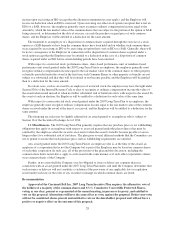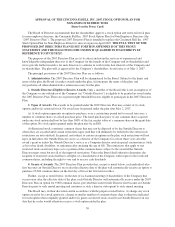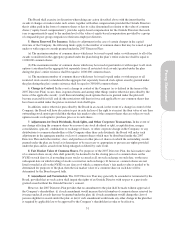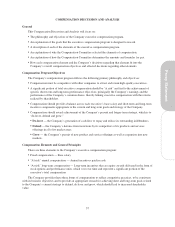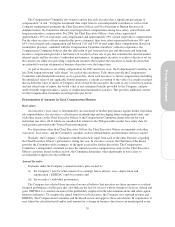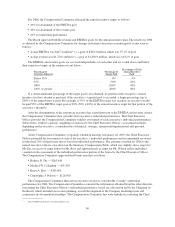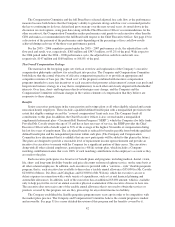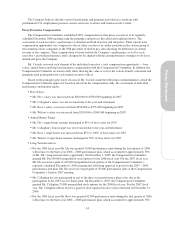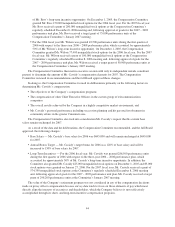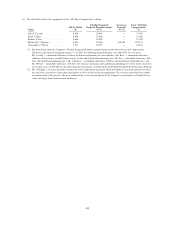Cincinnati Bell 2006 Annual Report Download - page 50
Download and view the complete annual report
Please find page 50 of the 2006 Cincinnati Bell annual report below. You can navigate through the pages in the report by either clicking on the pages listed below, or by using the keyword search tool below to find specific information within the annual report.Determining the Amount of Compensation
To determine appropriate ranges of compensation for executives, the Compensation Committee benchmarks
the Company’s compensation to make certain that it is in a competitive range and that an appropriate portion of
an executive’s compensation is “at risk”; that is, subject to payment only if the Company obtains certain
quantitative results and the individual achieves certain qualitative results. The Compensation Committee has
retained Mr. Charles Mazza, an independent compensation consultant, to assist it in its deliberations. In addition,
the Company retains Towers Perrin, a compensation consulting firm, to conduct a study of market place
compensation and practices. Towers Perrin obtains, compiles and supplies to the Company and the
Compensation Committee competitive compensation information. This information covers two groups:
•The first peer group consists of 19 telecommunications companies. The Company, in consultation with
Mr. Mazza, reviews the companies in this group to make certain their inclusion is appropriate, and the
Compensation Committee, after review, approves the peer group. The telecommunications peer group
currently includes:
•Alltel Corp. •Mediacom Communications Corp.
•AT&T •Qwest Communications International
•BellSouth Corp. •Sprint Nextel Corp.
•CenturyTel Inc. •Telephone & Data Systems
•Charter Communications Inc. •Time Warner
•Citizens Communications Co. •United States Cellular
•Comcast Corp. •USA Mobility Inc.
•Global Crossing Ltd. •US LEC Corp.
•Iowa Telecommunications Services Inc. •Verizon
•Level 3 Communications Inc.
•The second peer group is comprised of 112 companies across many industries with annual revenues
between $1 billion to $3 billion and are representative of compensation practices across many industries.
In establishing its compensation programs, the Company evaluates the following peer group data provided
by its independent advisors:
•Base pay.
•Total target cash compensation — the sum of base pay plus target annual bonus opportunity.
•Total target direct compensation — the sum of base pay plus target annual bonus opportunity plus target
long-term incentive opportunity.
Since executive compensation is correlated with a company’s annual revenue, the Company, in consultation
with its outside advisors, adjusts the compensation pay data to take into account differences in revenue among
companies using a statistical technique called “regression analysis.” Applying this technique at a market 50th
percentile against the Company’s annual revenue, Towers Perrin produces a suggested level of compensation for
each executive officer position whose compensation is assessed and set by the Compensation Committee and/or
the full Board in the case of the Chief Executive Officer.
The Company uses the market 50th percentile for setting its executive officer compensation for two reasons:
•Benchmarking at market 50th percentile is consistent with the practice followed by a majority of
companies.
•Targeting base compensation levels at the 50th percentile allows the Company to place a higher
proportion of the executive’s compensation at risk. The Company and the Compensation Committee
believe this is consistent with the concept of “pay for performance.”
Market data provide only a baseline of competitive pay information for the Company and the Compensation
Committee. The Compensation Committee considers other factors such as past and current pay levels, internal
equity considerations and performance when setting compensation levels for each executive.
38


